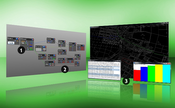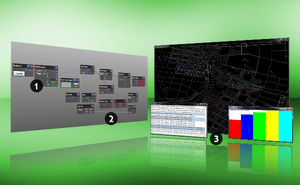Information
- Publication Type: Master Thesis
- Workgroup(s)/Project(s):
- Date: 2011
- TU Wien Library:
- First Supervisor: Martin Haidacher
- Keywords: Rapid Development, Dataflow Programming, Visual Programming, Visualization
Abstract
Over the years, many visualization tools and applications were developed for specific fields of science or business. Staying in the alcove of their field, these are highly suited and optimized for visualizing specific data, with the drawback of not being flexible enough to extend or alter these visualizations for other purposes.Often, customers of such visualization packages cannot extend them, to fit their needs, especially if the software is closed source. But even using open source software does not solve this problem efficiently, since to extend the software, costumers need to have programming skills and are often forced to reimplement algorithms or visualizations which already exist, making rapid development impossible.
The goal of this thesis is to develop a dataflow visual programming language (DFVPL) and a visual editor for the rapid development of visualizations. With this programming language, called OpenInsightExplorer, users can develop visualizations by connecting graphical representations of modules rather than writing source code. Each module represents a part of a visualization program. Modules are designed to function as an independent black box and they start to operate as soon as data is sent to them. This black box design and execution model allows to reuse modules more frequently and simplifies their development.
This programming language and its editor run platform independently to reach a high number of potential programmers, respectively users, to develop visualizations, since they are not bound to a specific platform. It is extendable, by means of self developed modules and data types to extend the language. Programming and editing a visualization is easy and fast, even for people with only little programming experience. The production cycle of the development of visualizations is reduced to a minimum. This is achieved by reusing and combining existing modules.
The usability of the programming language was evaluated by implementing two example visualizations with it. Each example originates from different areas of visualization, therefore demanding different data types, data transformation tasks and rendering.
Additional Files and Images
Additional images and videos
 OpenInsightExplorer:
Screenshot of the application
OpenInsightExplorer:
Screenshot of the application
Additional files
 OpenInsightExplorer:
Source code and binaries of the application
OpenInsightExplorer:
Source code and binaries of the application
Weblinks
No further information available.BibTeX
@mastersthesis{stehno-2011-RVD,
title = "Rapid Visualization Development based on Visual Programming",
author = "Benedikt Stehno",
year = "2011",
abstract = "Over the years, many visualization tools and applications
were developed for specific fields of science or business.
Staying in the alcove of their field, these are highly
suited and optimized for visualizing specific data, with the
drawback of not being flexible enough to extend or alter
these visualizations for other purposes. Often, customers
of such visualization packages cannot extend them, to fit
their needs, especially if the software is closed source.
But even using open source software does not solve this
problem efficiently, since to extend the software, costumers
need to have programming skills and are often forced to
reimplement algorithms or visualizations which already
exist, making rapid development impossible. The goal of
this thesis is to develop a dataflow visual programming
language (DFVPL) and a visual editor for the rapid
development of visualizations. With this programming
language, called OpenInsightExplorer, users can develop
visualizations by connecting graphical representations of
modules rather than writing source code. Each module
represents a part of a visualization program. Modules are
designed to function as an independent black box and they
start to operate as soon as data is sent to them. This black
box design and execution model allows to reuse modules more
frequently and simplifies their development. This
programming language and its editor run platform
independently to reach a high number of potential
programmers, respectively users, to develop visualizations,
since they are not bound to a specific platform. It is
extendable, by means of self developed modules and data
types to extend the language. Programming and editing a
visualization is easy and fast, even for people with only
little programming experience. The production cycle of the
development of visualizations is reduced to a minimum. This
is achieved by reusing and combining existing modules. The
usability of the programming language was evaluated by
implementing two example visualizations with it. Each
example originates from different areas of visualization,
therefore demanding different data types, data
transformation tasks and rendering.",
address = "Favoritenstrasse 9-11/E193-02, A-1040 Vienna, Austria",
school = "Institute of Computer Graphics and Algorithms, Vienna
University of Technology ",
keywords = "Rapid Development, Dataflow Programming, Visual Programming,
Visualization",
URL = "https://www.cg.tuwien.ac.at/research/publications/2011/stehno-2011-RVD/",
}

 Thesis
Thesis

